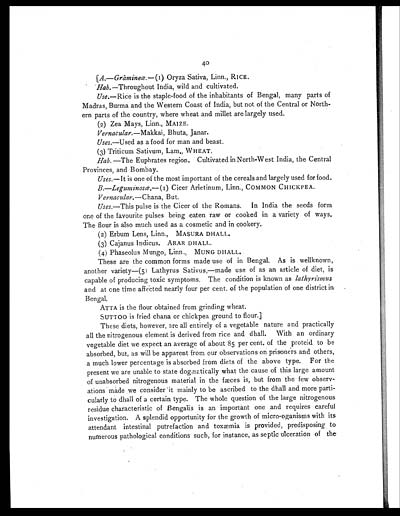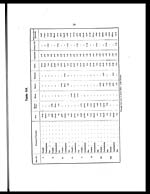Medicine - Institutions > Army health reports and medical documents > Scientific memoirs by officers of the Medical and Sanitary Departments of the Government of India > Number 34 - Standards of the constituents of the urine and blood and the bearing of the metabolism of Bengalis on the problems of nutrition > Standards of the constituents of the urine and blood and the bearing of the metabolism of Bengalis on the problems of nutrition
(48) Page 40
Download files
Individual page:
Thumbnail gallery: Grid view | List view

40
[A.—Grāmineœ.—(1) Oryza Sativa, Linn., RICE.
Hab.—Throughout India, wild and cultivated.
Use.—Rice is the staple-food of the inhabitants of Bengal, many parts of
Madras, Burma and the Western Coast of India, but not of the Central or North-
ern parts of the country, where wheat and millet are largely used.
(2) Zea Mays, Linn., MAIZE.
Vernacular.—Makkai, Bhuta, Janar.
Uses.—Used as a food for man and beast.
(3) Triticum Sativum, Lam., WHEAT.
Hab. —The Euphrates region. Cultivated in North-West India, the Central
Provinces, and Bombay.
Uses.—It is one of the most important of the cereals and largely used for food.
B.—Leguminosœ.—(1) Cicer Arietinum, Linn., COMMON CHICKPEA.
Vernacular.—Chana, But.
Uses.—This pulse is the Cicer of the Romans. In India the seeds form
one of the favourite pulses being eaten raw or cooked in a variety of ways.
The flour is also much used as a cosmetic and in cookery.
(2) Erbum Lens, Linn., MASURA DHALL.
(3) Cajanus Indicus. ARAR DHALL.
(4) Phaseolus Mungo, Linn., MUNG DHALL.
These are the common forms made use of in Bengal. As is wellknown,
another variety—(5) Lathyrus Sativus,—made use of as an article of diet, is
capable of producing toxic symptoms. The condition is known as lathyrismus
and at one time affected nearly four per cent of the population of one district in
Bengal.
ATTA is the flour obtained from grinding wheat.
SUTTOO is fried chana or chickpea ground to flour.]
These diets, however, are all entirely of a vegetable nature and practically
all the nitrogenous element is derived from rice and dhall. With an ordinary
vegetable diet we expect an average of about 85 per cent. of the proteid to be
absorbed, but, as will be apparent from our observations on prisoners and others,
a much lower percentage is absorbed from diets of the above type. For the
present we are unable to state dogmatically what the cause of this large amount
of unabsorbed nitrogenous material in the fæces is, but from the few observ-
ations made we consider it mainly to be ascribed to the dhall and more parti-
cularly to dhall of a certain type. The whole question of the large nitrogenous
residue characteristic of Bengalis is an important one and requires careful
investigation. A splendid opportunity for the growth of micro-oganisms with its
attendant intestinal putrefaction and toxæmia is provided, predisposing to
numerous Pathological conditions such, for instance, as septic ulceration of the
Set display mode to: Large image | Zoom image | Transcription
Images and transcriptions on this page, including medium image downloads, may be used under the Creative Commons Attribution 4.0 International Licence unless otherwise stated. ![]()
| Permanent URL | https://digital.nls.uk/75032378 |
|---|




